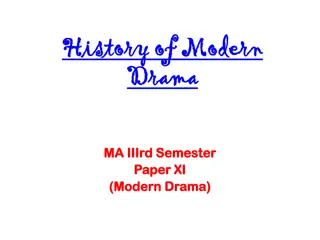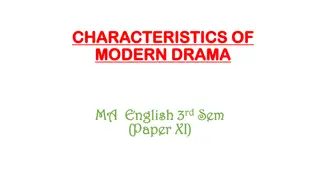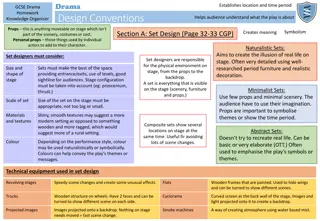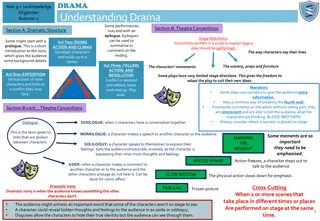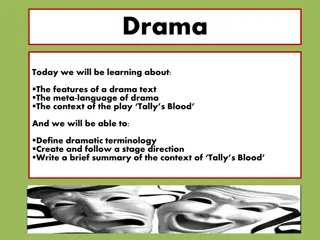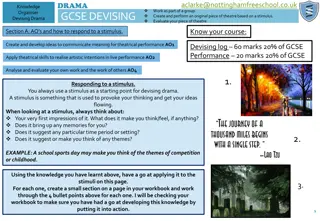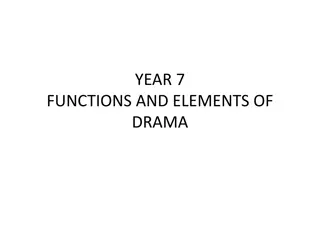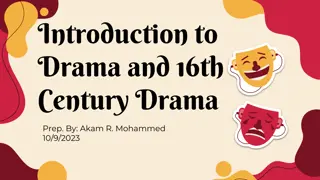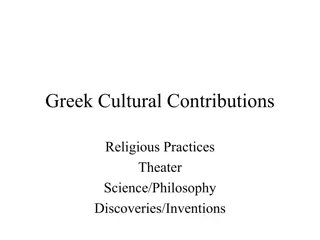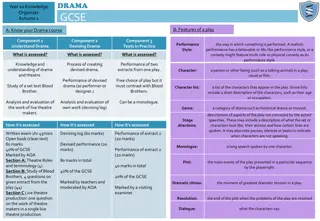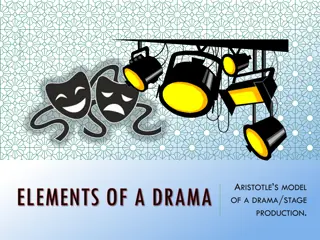Understanding the Elements of Drama and Theater History
Drama, originating from the Greek verb "dran," involves acting and storytelling in front of an audience. Explore the key aspects, from the Globe Theater in London to dramatic structure, actors, and speech forms like dialogue and monologue. Learn about the crucial components such as playwrights, actors, acts, scenes, and various speech types in theatrical performances.
Download Presentation

Please find below an Image/Link to download the presentation.
The content on the website is provided AS IS for your information and personal use only. It may not be sold, licensed, or shared on other websites without obtaining consent from the author. Download presentation by click this link. If you encounter any issues during the download, it is possible that the publisher has removed the file from their server.
E N D
Presentation Transcript
Drama The word drama comes from the Greek verb dran, which means to do. The Doing/Acting is what makes drama. The earliest known plays. . . Were written around the fifth century B.C Produced for festivals to honor Dionysus, the god of wine and fertility
Drama is a story told in front of an audience.
The Globe Theater Where many of Shakespeare s plays were performed in London, England Open during summer months Daytime performances only Open-Air; O-shaped Burned by cannonball landing on the roof during a performance
Globe Theater Groundlings paid one cent to stand in the pit Gentry paid more for seats in galleries Nobles sat in chairs on side of stage
Dramatic Structure Like the plot of a story, the plot of a play involves characters who face a problem or conflict. Climax point of highest tension; action determines how the conflict will be resolved Complications tension builds Resolution conflict is resolved; play ends Exposition characters and conflict are introduced
Elements of Drama The People Playwright-the author of a play Actors-the people who perform The Play Acts-the units of action Scenes-smaller parts of the acts
Actors During Shakespeare s time, women were not allowed to act All female roles were played by men (usually by young boys)
Dramatic Speech The characters speech may take any of the following forms: Dialogue- conversations of characters on stage Monologue- long speech given by one character to the others Soliloquy- speech by a character alone onstage to himself, herself, or to the audience Aside- remarks made to the audience or to one character: the other characters onstage do not hear an aside
Stage Directions Found in brackets [ ] Describe scenery and how characters speak From the viewpoint of the actor looking at the audience C, Center Stage L, Stage Left R, Stage Right U, Upstage or Rear D, Downstage or Front
There are two [main] types of plays Tragedies Comedies
Tragedy A tragedy is a play that ends unhappily. Most classic Greek tragedies deal with serious, universal themes such as right and wrong justice and injustice life and death Tragedies put human limitations against the larger forces of destiny.
Tragedy The protagonist of most classical tragedies is a tragic hero. This hero: pride is noble and in many ways admirable rebelliousness has a tragic flaw, a personal failing, that leads to a tragic end jealousy
Comedy A comedy is a play that ends happily. The plot usually centers on a romantic conflict. boy wins girl boy loses girl boy meets girl
Comedy The main characters in a comedy could be anyone, from any walk of life.: servants nobility townspeople
Comedy Comic complications always occur before the conflict is resolved. In most cases, the play ends with a wedding or two or three.
Language of Shakespeare Meter is a rhythm of accented and unaccented syllables which are organized into patterns, called feet. Using the same meter throughout a play helped actors memorize their lines. Shakespeare used iambic pentameter as his meter.
Iambic Pentameter Iambic foot (Iamb) a pair of syllables containing short/long or unstressed/stressed syllables. Pentameter= five So Iambic pentameter is a line that contains five iambs (10 syllables in an unstressed--stressed pattern) Makes a sound like a heartbeat daDUM daDUM daDUM daDUM daDUM
Examples When I do count the clock that tells the time when I do COUNT the CLOCK that TELLS the TIME To swell the gourd, and plump the hazel shells to SWELL the GOURD, and PLUMP the HAzel SHELLS and here it is explained another way
Mrs. Vessells #1 Pet Peeve: Shakespeare did notwrite in Old English; in fact, it is actually very similar to the English that we speak today. Old English Middle English



